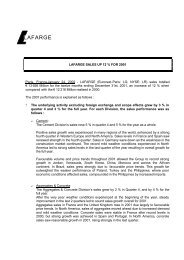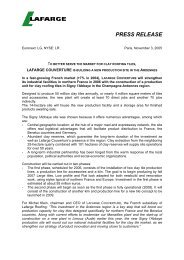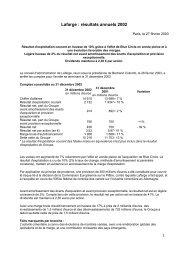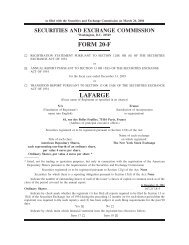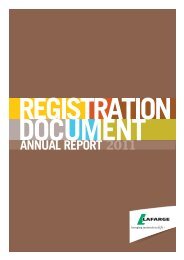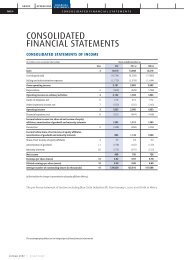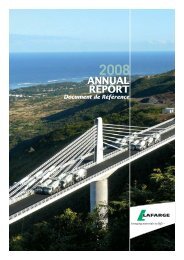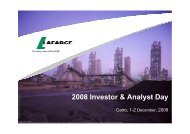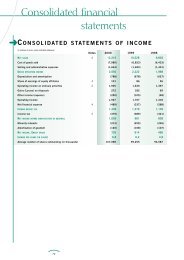2005 Sustainability Report - Lafarge
2005 Sustainability Report - Lafarge
2005 Sustainability Report - Lafarge
Create successful ePaper yourself
Turn your PDF publications into a flip-book with our unique Google optimized e-Paper software.
Contributing to local economic development<br />
Our Principles of Action put to work<br />
after the tsunami in Indonesia<br />
Here are some examples:<br />
OUR COMMITMENTS / OUR PRINCIPLES OF ACTION ACCOMPLISHMENTS IN INDONESIA<br />
Giving our people every opportunity<br />
to contribute and develop their talents<br />
Helping build a better world<br />
in our communities<br />
Acting as responsible members<br />
of our communities by contributing<br />
to the development of people, their health,<br />
rights and well being by generating<br />
economic growth and supporting social,<br />
educational and cultural advancement<br />
Being firmly committed to the protection<br />
of the environment<br />
Generating value for our customers<br />
Delivering the value creation<br />
that our shareholders expect<br />
PAGE 38 | <strong>2005</strong> SUSTAINABILITY REPORT | LAFARGE<br />
On December 26, 2004, a vast tidal wave caused by a severe earthquake devastated the<br />
coastlines of the Indian Ocean. <strong>Lafarge</strong>, which operates the PT Semen Andalas cement plant<br />
in Lhoknga, Indonesia, was directly confronted by the disaster, which left 193 of its 625 plant<br />
employees and permanent subcontractors either dead or missing.<br />
A major economic force in the region, the Group put the necessary resources into action and took<br />
advantage of its knowledge of the local charitable, religious, political and entrepreneurial organizations<br />
to handle the emergency situation and then to reorganize and rebuild life in the long term.<br />
As with each of our projects, our involvement in Indonesia is managed in line with our commitments,<br />
as set out in the <strong>Lafarge</strong> Way, and our Principles of Action.<br />
We involved our employees in our programs as much as possible.<br />
For instance, a hundred of them were allocated to the housing rebuilding project.<br />
Others opted to receive training and financial assistance to start up their own business.<br />
The gradual upturn in the plant's business will be backed up by social support<br />
and appropriate training.<br />
We implemented a reconstruction program for earthquake-resistant permanent<br />
housing using natural resources with energy-efficient technologies, backed up<br />
by economic support programs for the entire duration of the work.<br />
We decided to reconstruct the plant, set up a mobile clinic, renovated schools, supplied<br />
school equipment, refurbished mosques and delivered training in masonry activities.<br />
Wages were paid to all employees in spite of the interruption in economic activity,<br />
and financial assistance was paid to the families of those who died.<br />
Subsidies were also given to address housing problems during the first few months<br />
after the disaster.<br />
We selected the materials used to rebuild housing to eliminate the use of wood thus<br />
contributing to the fight against deforestation.<br />
<strong>Lafarge</strong> continued to deliver to its customers in the region by importing cement<br />
from Malaysia, setting up a mobile maritime bagging unit and building a mobile<br />
terminal to supply the region. These measures helped to ensure that cement supplies<br />
continued to get through to the Aceh province, where demand soared as a result<br />
of the construction of emergency camps. It is strategically important for <strong>Lafarge</strong><br />
to maintain its market share to ensure the sustainability of its economic activities.<br />
<strong>Lafarge</strong> aims to pursue its objective of reestablishing a strong and self-confident<br />
community equipped with production facilities when the plant re-enters service<br />
in late 2007. It is essential for the social and economic functions of the local community<br />
surrounding the plant to have been restored before its activities can resume.




